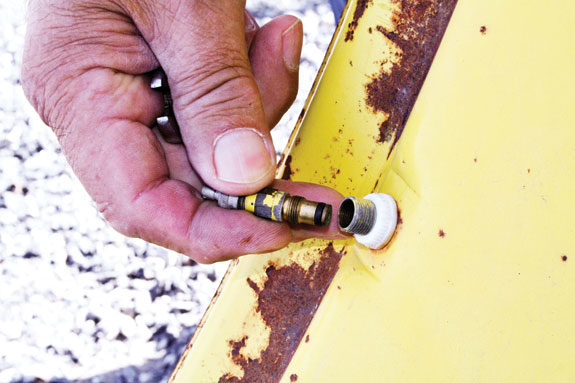A few years back, I was working on a big project. I needed to plant 120 acres of triticale for a dairyman. I got everything greased, lubed and fueled up the night before and thought I was all ready to go. The next morning I was up early and out in the field working. I noticed that I wasn’t sitting square in the seat, but I thought it was just me. When I finally decided to get off and look at it, the right outside tire was flat and the sidewall was eaten up because I had driven on it for so long. It was an older tire and in a newer application it probably wouldn’t have done that, but this one was old and brittle and it really flexed it. In the end, I found out that something in the field had punctured the tire. This is an example of how easily things can go awry in the field, regardless of the preparation.
Compaction
Dual tractor tires help distribute the weight of the tractor, to help with compaction, and give the tractor better traction. As tractors get bigger and heavier, they put a lot of weight on the ground and soil. If you don’t use the right tires on certain crops, the compaction can really hurt your yields.
Now, the tractor tires are really big and that’s to help give it a bigger footprint. You can’t believe the compaction that happens in the fields when silage trucks come in on relatively small tires and a lot of weight. Truck tires have not changed much, but they have increased the weight that they carry.
Traction
Traction is very important, especially when you are in wet or sandy soil. You won’t be doing much work if you don’t have the right set of tires. Those conditions are also the reason tractors are four-wheel-drive with some of the power going to the front wheels, so it can pull the weight instead of pushing it. The ratio for power is usually about 40-to-60; 40 percent to the front tires and 60 percent to the back.
Some people get carried away with adding weight to the tractor to get better traction, but that can be bad on tires, increasing compaction and reducing horsepower. Too much weight can also cause transmission and final drive failures if you don’t have the proper slippage. You need about 8 to 10 percent slippage, which can be calculated by the computer on the tractor or mathematically.
Be aware of the total weights your tires can hold when adding counter- weights and pulling large implements. Check with your tractor dealership or tire repair center for proper calcium chloride fluid level and wheel weights.
Application
There have been some modifications, such as larger diameters and narrower tires, improved tread and even the use of nitrogen gas to inflate the tire. Most farmers know about water weight and why it has been used for many years.
Due to freezing temperatures, other solutions have been added to water to keep it from freezing, like calcium chloride. Many farmers still use calcium chloride, which lowers the freezing point. However, calcium chloride is very corrosive and will eat up the stems as well as other related tire and rim parts. If the tire gets punctured, the calcium chloride will leak out and damage the soil’s growth potential.
New technology
Another option used in tires instead of calcium chloride is steel wheel weights inside of the rim. Currently, these wheel weights are the newer technology and are used more often than calcium chloride, as they increase the footprint of radial tires.
Nitrogen sometimes can be used as a substitute for air, because of its properties. Nitrogen molecules are larger than oxygen and won’t leak as much. Nitrogen molecules don’t change size due to heat as much as oxygen.
If your tire has water or calcium chloride in it, make sure the stem is up or to the top of the tire when you check the air pressure. Make sure to use an air compressor to blow air back into the tire, eliminating any calcium chloride that may have become trapped in the stem, which could enter the air gauge and damage it.
Mechanic’s tip: It is not necessary to fill the tire up over the stem with calcium chloride, otherwise the tire will not have any room for flexing. Sometimes a flat tire may just be a bad stem. Before changing the tube, check your stem. Calcium chloride will eat the O-ring and valve stem core. They can be changed easily. You may be able to save some money by just switching the O-ring or the stem. PD
PHOTO : Flat tires are sometimes caused by eroded valve stems. Check the valve stem before replacing the entire tube. Photo by PD staff.
Do you have a mechanical question? Mechanics Corner will answer it in a future issue. Send your questions to dario@progressivedairy.com

-
Jim Schlund
- Retired Diesel
- Mechanics Professor
- College of Southern Idaho








